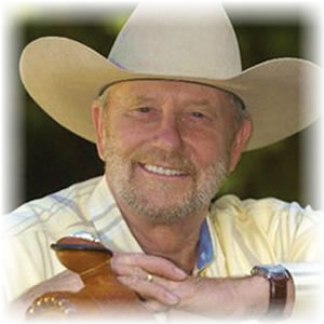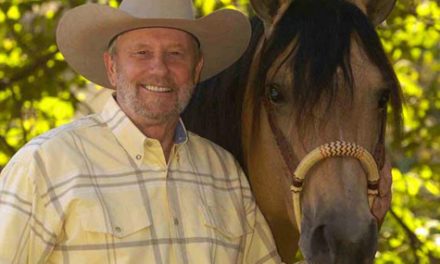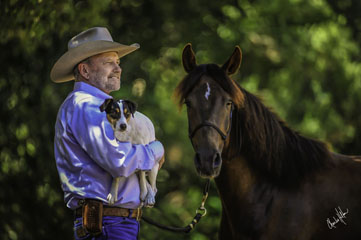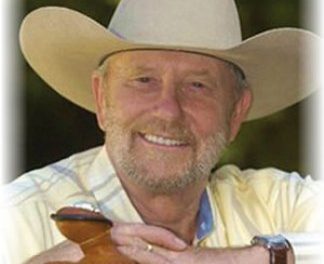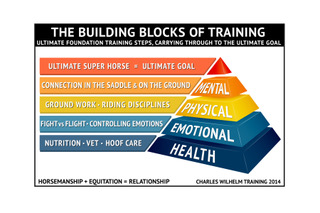 Each horse is different and the amount of time to spend on training depends on the age of the horse, the physical condition, where the horse is at in his training and his personality. By personality I mean his emotional level. Is the horse flighty or calm, willful or compliant? These factors determine how quickly the horse can learn.
Each horse is different and the amount of time to spend on training depends on the age of the horse, the physical condition, where the horse is at in his training and his personality. By personality I mean his emotional level. Is the horse flighty or calm, willful or compliant? These factors determine how quickly the horse can learn.
Hard riding without a thought out method or goal is riding a horse into the ground. That accomplishes nothing and there is usually some negative emotion at work. Working your horse with a goal until he breaks into a sweat doesn’t mean you have ridden him into the ground. Running a horse up a hill when the horse is out of shape is running a horse into the ground if you are working your horse just to wear him out, this is the wrong approach. Being run into the ground in that way can sour a horse. The length of the lesson must be tailored to your horse. The number one consideration is your safety followed by the safety of the horse.
When we work a horse here at the ranch, we try to work through the issue until we can see a significant change, meaning a break through, a definite improvement from the previous behavior. We warm the horse up first with ground or in-hand work to get the horse listening and responding. Once we get into the saddle, we continue the warm up using suppling exercises for the neck and shoulders. These exercises help to keep the shoulders upright and help the horse to be balanced. After this we hone in on the problem or issue.
For example, a horse has been performing well at the trot but drops his shoulder and turns too quick when put into a canter. The shoulder must stay upright and not be dropped. Or, a horse is heavy on the forehand. The horse must learn to come up under himself. These may be long-term chronic issues. Depending on the horse, I may work on an issue for an hour or even two hours. Some people think that is too long but I believe in stopping when I see a significant change in the horse. It doesn’t have to be perfect. Nevertheless, I want to feel the shoulder more upright and not dropping as radically. Both of these horses must be coming more from the rear in order to support the upright shoulders.
If you stop the training without seeing a change in the behavior, you are approving the behavior and teaching the horse that the behavior is acceptable. Where you leave off at the end of the lesson is where you are going to start the next time. In the long run, it is easier on you and the horse to get the change initially. It doesn’t have to be a huge change but it must be a significant change you will not get the behavior totally changed in one session but you need to see some change. Then come back the next time and reinforce the learning.
Whether you are training a young horse or you are schooling an older horse that has developed bad habits, it may take weeks or months to reach the level of performance you are seeking. It is good to work a horse several days each week but you must determine the amount of time to spend in each lesson. I have had horses that are easy to work with and I see a significant change in the behavior almost immediately. That doesn’t mean the problem is fixed forever. I work on the issue again the next day. I may need to spend thirty minutes a day for several days.
There is nothing wrong with taking a break during the lesson to let the horse relax, calm down and air up (catch it’s breath). I consider this “think time” for the horse. I always stop when the horse has done something positive. A quiet few minutes allows the horse a chance to settle and process. You can stay in the saddle and just let the horse walk around or stand still. I have found that horses do process. The second or third time around, their willingness improves. The concept is to get the mind of the horse engaged so that learning can occur
All training is based on foundation blocks of learning. I always start with the basic foundation skills and build. For example, when I teach a horse to trailer load, I complete all the related groundwork exercises before I go near the trailer. I make sure the horse is respecting my space, listening and paying attention to me. The horse must respond to my forward cue by going over poles and tarps, objects that are scary like a trailer. I spend a long time ground schooling but when I get to the trailer, I may need to spend only 15 minutes working with the horse until he walks in. This is because I laid the basic foundation by doing the groundwork.
Another thing to keep in mind is that we need to make sure the problem is a training problem and not health related. I will usually have the chiropractor or the dentist look at a horse to make sure the issue is training and not a physical problem.
It is important to learn to ride correctly and not create a problem. One of my clients who has ridden for years recently told me it is very hard work to learn to ride correctly. Old, bad habits are hard to break. When our muscle memory causes us to move incorrectly, we need to really concentrate as we ride to create correct habits. Also, when we ride improperly, we are actually schooling the horse to perform incorrectly. This doesn’t mean you have to be a crack rider. It does mean that you need to teach your horse to be obedient, to be between the reins, to be elevated and use himself correctly, in other words, to come from or drive from the rear. Think about your time and plan for the work out.
* Make sure your horse has a training need and not a physical problem.
* Set a goal and create a game plan.
* Give the horse short breaks.
* Try not to quit until you see a significant change. Be prepared to spend the time it will take. That can mean 20 minutes or an hour and a half.
When you get a break through, stop. You will be starting the next lesson at the point you left off and not from the beginning.

